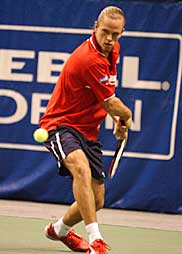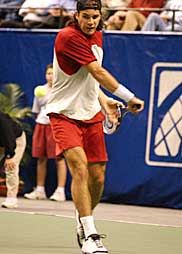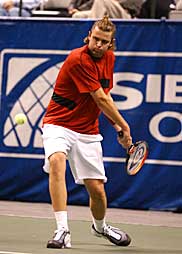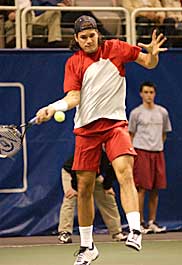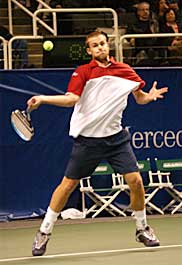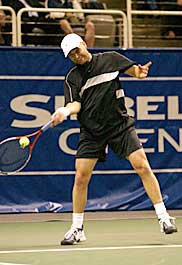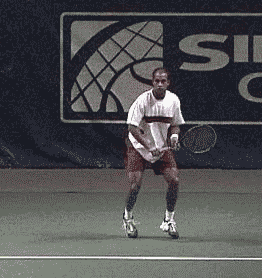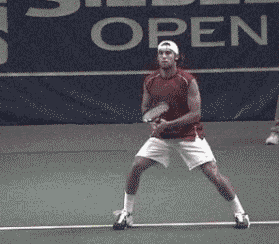|
TennisOne Lessons
First Things First - Arm/Hand/Racquet By Jim Mclennan Photos by Bill Putnam
Welcome back to the First Things First Suite. The premise has been to focus on the basics, and I mean really the basics. Without reference to general tennis tips, the intent here is to build your own awareness of your balance, the position of your head during the swing, the manner in which you shift your weight, and how it feels when you swing your hips to and fro. First Things First begins with the point (your center) and moves to the periphery (the swinging racquet). But just as a spinning top either spins perfectly, or wobbles, slows down, and falls, you too can feel the balance and efficiency of a spinning top, and allow the periphery to take care of itself. So lets go to the throwing motion. I sometimes ask pupils, “Does throwing feel like pulling or pushing?” And as you read this, an interesting experiment is to throw with the non-dominant arm and then answer this question. I observe that generally the best throwers can “feel” how the shoulders pull the arm, how the loose arm pulls the hand, how the elbow tends to precede the hand, and how the loose hand finally pulls the ball. Conversely, we may have all seen throwers “push” the ball. I do have a daughter. I do not ever use the phrase “throws like a girl”, but that picture generally conjures the pushing image. With quiet awareness, and specific tasks, I find that most pupils can discover a fluid throwing action. And interestingly, once felt (at whatever level of proficiency) this throwing feel generally enhances awareness of racquet swinging skills.
Similarly, one can monitor their pulling action on the forehand, the backhand, the serve, and even the volley. The pulls may be longer or shorter, faster or slower, but in all cases an easy yet organized pull is the key.
Sequencing – the pulling levers in the upper body are the torso/shoulder – upper arm – forearm – hand – and racquet. Ideally one would use a sequence from point to periphery (see Jack Broudy 8-board articles) where the torso/shoulder led the upper arm, which led the forearm, which led the hand, which led the racquet. When swinging the forehand in this manner (or throwing) the picture is one of rhythm and looseness. When tight, these levers will become essentially one unit, where the torso turn is connected rigidly to the racquet (or ball), it hurts to even visualize such a stroke. Alternately, when the swing (or throw) is done loosely but only with the hand (without earlier pulls from the shoulder and arm) then we all recognize a “wristy” swing (or toss). This will be about your awareness of all the elements in the pulling action.
Before the swing itself, a final note on rhythm. Watch the quarterback, the ball thrower, even Agassi or Sampras. In each case the preparatory turn is continuous with the forward turning/swinging motion. Again, there is not a turning back to throw or swing, then a dead stop, then a restarting back to throw/swing. Rather, and this is important, there is a rhythm, a rolling motion where the preparation starts a continuous throwing/swinging action. Continuity, musical, not static poses. Joe Montana, Pete Sampras, these are lyrical actions, and we can learn to feel our own version of that gracefulness. So on the forehand (but this analogy works equally well on the backhand, the serve, and in an abbreviated fashion on the volley) the continuity works as follows. Incoming ball – turn, good posture, quiet hands, weight shifting to the back foot, then the “trigger” of the step to the front foot elicits the swing. So how does the racquet go back? Do you take it back? No. Do you point it to the back fence? No. From point to periphery you simply allow it to go back. You can feel it go back because the momentum of the initial preparatory turn when connected to the forward turn (without a hitch or dramatic “take the racquet back” thought) will actually enable the arm to swing back and away from the body.
Sitting at your chair in front of the computer screen, you can experiment with the throwing motion. If you draw your shoulders back, holding your arm and hand loosely, and then turn your shoulders forward, the arm actually continues swinging backward for a moment. Just like a dog wags its tail, your arm will wag from the shoulder. Wagging is the key. Now to feeling the sequence. The video clips show continuity. They emphasize the whole picture not the parts. Watch any of the images many many times. Imagine you are demonstrating just such a swing. Then as you step away from the computer screen, try shadowing the swing in your living room (or office). Monitor how the stroke feels. Go to awareness rather than evaluation. Internal observation instead of self-criticism. The pulling analogy works. It does describe how the pros do it. It also describes how the more graceful and efficient players at your club make it look. It is a worthy ideal to pursue. A journey more than a destination. As you approach your own version of this pulling sequence you will notice using less effort, sometimes hitting the ball much harder than you imagine. You may even hear someone tell you, “Wow, you sure made that look easy.” Feel free to respond as you wish to that compliment.
Final thoughts. Volleys are different than forehands, and they are both different than serves. The question becomes, if I am pulling, then how fast, low long, and how hard? The answer has to do with the incoming rebound potential of the ball, its potential energy. As you receive more energy from the ball, pull slower and less forcefully. As you receive less energy from the ball, pull in a longer, faster and more forceful action. Said another way, pull the racquet easily into a volley because the incoming ball has so much speed and rebound energy. Pull in a longer and faster arc on the groundstroke because the incoming ball has bounced and lost some of its potential energy. And finally, pull in a long, fast and whiplike action on the serve because there is next to no rebound potential from the toss, especially if you hit it at its peak. We do pull on the hammer, we do pull on the golf club, and we pull on the bullwhip. Certainly something similar will work on court with the racquet. Your comments are welcome. Let us know what you think about Jim McLennan's article by emailing us here at TennisOne.
|
|||||||||||||||||||||||

